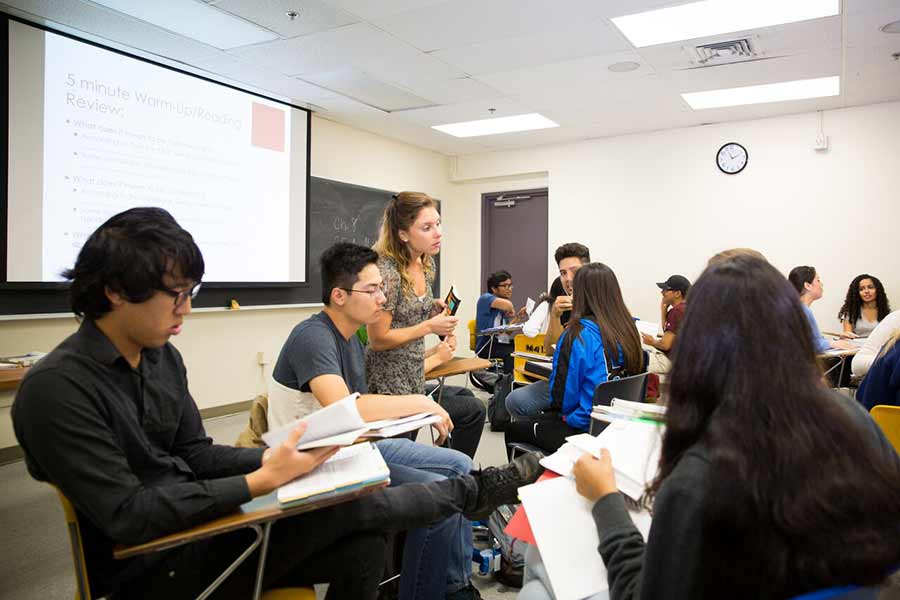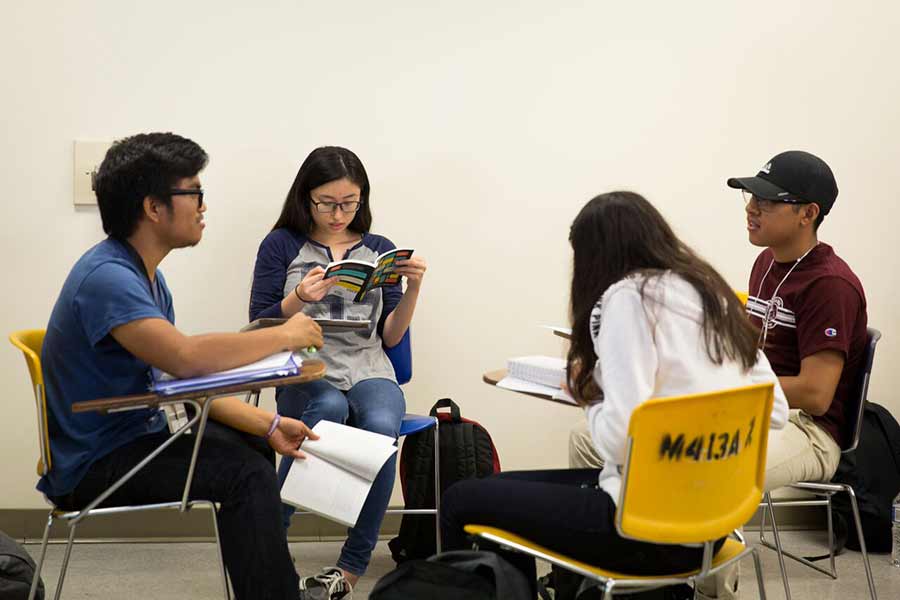
By:
- Cynthia Dillon
Published Date
By:
- Cynthia Dillon
Share This:
UC San Diego’s Division of Arts and Humanities Helps Students the “Write” Way
UC San Diego’s Division of Arts and Humanities is devoted to developing students’ skills of critical thinking and analytic expression. Those skills include writing analytically. Some students, however, who enroll at the university—including some first-generation, underrepresented and international students—have not yet met the University of California’s entry-level writing requirement. So, the division gives them a boost toward graduation success with its Basic Writing Program.

Instructor Jaclyn Krizovensky assists students during her class to strengthen students’ writing. Photos by Farshid Bazmandegan
Led by Karen Gocsik, writing professor and program director, the Basic Writing Program offers eligible students a new platform from which to develop their writing prowess. Rather than requiring students to take a timed exit exam to pass into college writing, the program puts student work at the center of its courses. Students now present a portfolio of written product that is assessed to determine their readiness for college-level writing.
At UC San Diego, each of the six colleges that comprise the campus require enrolled students to pass that college’s specific writing requirements. The Basic Writing Program prepares students to meet those requirements with a systematic approach that allows students several opportunities to reflect on and revise their work. The rigorous new curriculum engages students in the same type of work that they will encounter in their college writing programs.
“Indeed, it takes a village to build a state-of the-arts program,” said Dean of the Division of Arts and Humanities Cristina Della Coletta. “In less than one year we put together a team of instructors who, under Karen’s leadership, are propelling a program of innovation and excellence.”
According to Della Coletta, the team is well-grounded in sound pedagogy yet nimble enough to meet the needs of a growing and changing student population, which includes about 1,000 program participants this year.

Students work in groups in the Basic Writing Program.
The new approach seems to be working. For example, last fall, when the new curriculum was piloted, the pass rate rose from 46 to 86 percent in one course, and from 31 to 66 percent in the other course. Among students who had experience with both the previous and the new curriculum, 95 percent reported that they preferred the new program. Reportedly, student satisfaction is high, with 90 percent of students surveyed confirming that the curriculum effectively helped them meet each of nine course goals.
According to Gocsik, students appreciate that the program acknowledges the intelligence and abilities that they bring with them to the university while also addressing the challenges they face as they learn to write in English for an American university.
“Coming from the Ivory Coast and studying in the French system, I had a lot of difficulties when it came to abandoning aspects of the way I used to write, because it felt like abandoning a part of who I was,” explained Aliya Kassam, a student majoring in mechanical engineering and minoring in psychology. “The truth is that you might be excellent in your own language, have a rich vocabulary, but you have to accept that you need to adapt to this new academic environment and learn its mechanisms. Although at first I wasn’t thrilled with the idea of having to take Basic Writing, it proved to be very beneficial. I rediscovered myself as a writer.”
Basic Writing Program students come from all over the world, as well from California. They are bright, curious and intellectually driven students who share a common experience of not yet being fully prepared for the demands of college writing, explained Gocsik.
“It’s exciting to teach these students—to watch them work out their intellectual questions and learn how to express their newly wrangled ideas clearly, in writing.”
Share This:
You May Also Like
Stay in the Know
Keep up with all the latest from UC San Diego. Subscribe to the newsletter today.


